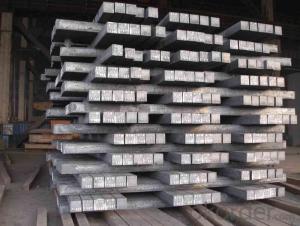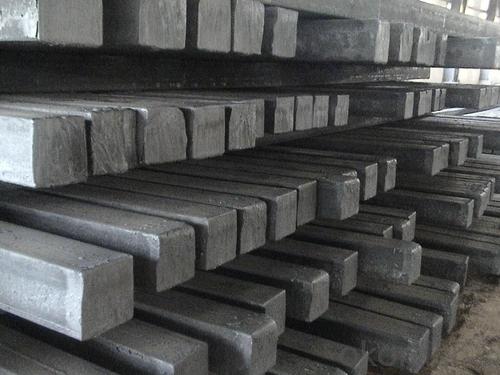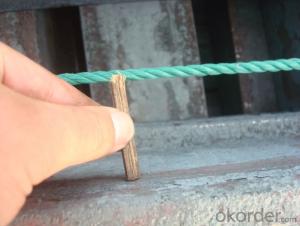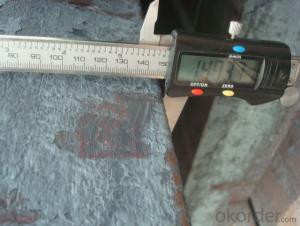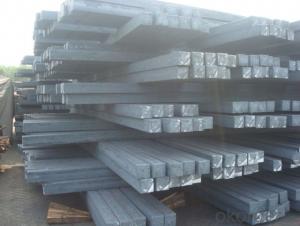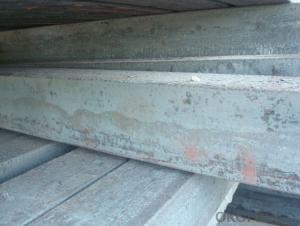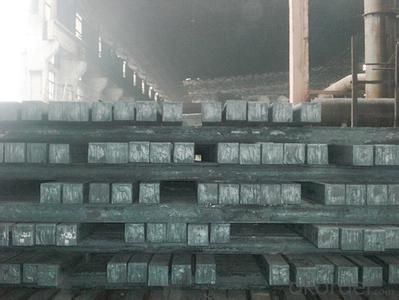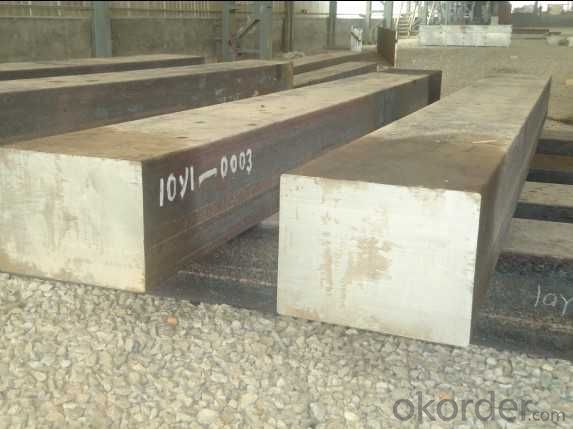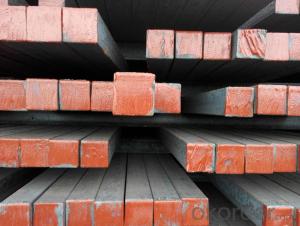Hot rolled Steel Square Billets Q195 and Q235 with High Quality for Construction
- Loading Port:
- China main port
- Payment Terms:
- TT or LC
- Min Order Qty:
- 25000 m.t.
- Supply Capability:
- 200000 m.t./month
OKorder Service Pledge
OKorder Financial Service
You Might Also Like
Specification of Hot rolled Steel Square Billets Q195 and Q235 with High Quality for Construction:
Chemical Composition. Q195
Standard | Grade | Element (%) | ||||
GB | Q195 | C | Mn | S | P | Si |
0.06~0.12 | 0.25~0.50 | ≤0.050 | ≤0.045 | ≤0.30 | ||
Chemical Composition. Q235
Standard | Grade | Element (%) | ||||
GB | Q235B | C | Mn | S | P | Si |
0.12~0.20 | 0.30~0.70 | ≤0.045 | ≤0.045 | ≤0.30 | ||
Technology process of Hot rolled Steel Square Billets Q195 and Q235 with High Quality for Construction:
1.Heat the EVA film
2.Cover the heated EVA film on the mould(can be made from wood or aluminum)
3.Spray a coating in a certain baume degree
4.Put on the empty blask
5.Sand-up the flask and vibrate to compaction
Packaging & Delivery of Hot rolled Steel Square Billets Q195 and Q235 with High Quality for Construction:
Packaging Details:containers
Delivery Detail:Complete one set of equipment needs for three months
The products can be delivered by bulk vessel or by container. As for container, products with the length of 6m will be loaded in 20’ container, with 9m or 12m, in 40’ container.
-The maximum quantity of loading of container is 25 tons.
-The products usually are transported to the nearest port from the production place.
FAQ:
Q1: How soon can we receive the product after purchase?
A1: Within three days of placing an order, we will begin production. The specific shipping date is dependent upon international and government factors, but is typically 7 to 10 workdays.
Q2: What makes stainless steel stainless?
A2: Stainless steel must contain at least 10.5 % chromium. It is this element that reacts with the oxygen in the air to form a complex chrome-oxide surface layer that is invisible but strong enough to prevent further oxygen from "staining" (rusting) the surface. Higher levels of chromium and the addition of other alloying elements such as nickel and molybdenum enhance this surface layer and improve the corrosion resistance of the stainless material.
Q3: Can stainless steel rust?
A3: Stainless does not "rust" as you think of regular steel rusting with a red oxide on the surface that flakes off. If you see red rust it is probably due to some iron particles that have contaminated the surface of the stainless steel and it is these iron particles that are rusting. Look at the source of the rusting and see if you can remove it from the surface.
Images:
- Q: How are steel billets used in the production of electrical transmission towers?
- Steel billets are used in the production of electrical transmission towers as they serve as the raw material for the manufacturing process. These billets are melted and then shaped into the required sections and components of the transmission tower, such as the main legs, cross arms, and braces. They undergo further processing, including cutting, drilling, and welding, to form the final structure. The strength and durability of steel make it an ideal material for transmission towers, ensuring they can withstand the weight of electrical cables and withstand harsh environmental conditions.
- Q: How are steel billets used in the manufacturing of tooling?
- Steel billets are used in the manufacturing of tooling as they serve as the raw material for shaping and forming various types of tools. The billets are heated, forged, and machined to create tooling components such as dies, molds, and cutting or shaping tools. The high strength and durability of steel make it an ideal choice for tooling applications as it can withstand the demanding conditions and repetitive use typically required in manufacturing processes.
- Q: How are steel billets used in the manufacturing of construction formwork?
- Construction formwork relies heavily on steel billets as a vital component. Formwork, which encompasses temporary or permanent molds or structures, is crucial for holding and supporting newly poured concrete until it solidifies. To create the formwork, semi-finished steel products known as steel billets are employed as the raw material. Typically, these billets are cast from molten steel into rectangular or square shapes and cooled to solidify. The resulting billets undergo further processing to produce the specific formwork components. Initially, the steel billets are cut into smaller sections, according to the desired formwork dimensions. These sections are then shaped and welded together to form the framework. The billets offer the necessary strength and durability to withstand the weight of concrete and external forces during construction. Following the completion of the framework, additional components such as panels, braces, and tie rods are attached. These components, also made from steel billets, enhance stability and distribute the load evenly across the formwork. Steel billets are the preferred material for formwork construction due to their high strength-to-weight ratio and exceptional resistance to corrosion. They can endure the pressure exerted by poured and curing concrete, ensuring the formwork remains intact and stable. Furthermore, steel billets are easily molded and shaped into diverse configurations, allowing for flexibility and customization in formwork design. In conclusion, steel billets play a vital role in manufacturing construction formwork. They provide the necessary strength, durability, and stability required to support freshly poured concrete until it solidifies. By utilizing steel billets, formwork manufacturers can create robust and reliable structures that contribute to efficient and safe construction processes.
- Q: What are the challenges faced in steel billet manufacturing?
- There are several challenges faced in steel billet manufacturing. One of the main challenges is achieving consistent quality and uniformity in the billets. Steel billets need to have a specific chemical composition and physical properties to meet the requirements of the end products they will be used for. However, variations in raw materials, such as iron ore and scrap metal, can affect the quality of the billets. Maintaining consistent quality throughout the production process is crucial but can be difficult due to the variable nature of the raw materials. Another challenge is ensuring the proper heat treatment of the billets. Heat treatment is necessary to enhance the mechanical properties of the steel billets, but it requires precise control of temperature, time, and cooling rates. Any deviation from the recommended heat treatment process can result in inconsistent mechanical properties, leading to a decrease in the overall quality of the billets. In addition, the production of steel billets involves complex and energy-intensive processes. The manufacturing facilities need to have advanced equipment and technology to handle the high temperatures required for melting and casting the steel. The continuous casting process, which is commonly used for billet production, also requires precise control of various parameters, such as casting speed and cooling rates. Maintaining the equipment and ensuring its proper functioning can be a challenge in itself. Moreover, environmental concerns pose challenges in steel billet manufacturing. The process generates significant emissions of greenhouse gases, particulate matter, and other pollutants. Strict environmental regulations and the need to reduce the carbon footprint of the manufacturing process require steel producers to invest in energy-efficient technologies and implement sustainable practices. Lastly, the market demand for steel billets can be volatile, leading to challenges in production planning and inventory management. Fluctuations in demand can result in overproduction or stockouts, which can impact the overall efficiency and profitability of the manufacturing process. Overall, steel billet manufacturing faces challenges in maintaining consistent quality, achieving proper heat treatment, managing energy-intensive processes, addressing environmental concerns, and adapting to market dynamics. Overcoming these challenges requires continuous improvement, investment in technology, and adherence to stringent quality standards.
- Q: Are steel billets used in the shipbuilding industry?
- Yes, steel billets are commonly used in the shipbuilding industry. Steel billets are semi-finished steel products that are typically used as raw materials for further processing. In shipbuilding, these billets are typically used to manufacture various structural components, such as plates, beams, and bars that make up the structure of a ship. The high strength and durability of steel make it an ideal material for shipbuilding, as it can withstand the harsh conditions of the marine environment. Additionally, steel billets can be easily shaped and welded, allowing for the construction of complex ship structures. Overall, steel billets play a crucial role in the shipbuilding industry by providing the necessary raw materials for constructing strong and reliable ships.
- Q: What are the different surface treatments for improved dimensional accuracy in steel billets?
- Some of the surface treatments for improved dimensional accuracy in steel billets include shot blasting, grinding, and polishing. Shot blasting involves propelling abrasive particles onto the surface to remove any imperfections or scale, resulting in a smoother and more uniform surface. Grinding is another technique that uses abrasive wheels to remove material and achieve precise dimensions. Lastly, polishing is a process that involves using fine abrasives to further smoothen the surface and enhance dimensional accuracy.
- Q: How are steel billets used in the production of automotive suspension components?
- Steel billets are used in the production of automotive suspension components due to their strength, durability, and malleability. Billets are essentially semi-finished steel products that are formed into specific shapes, such as bars or rods, through a process called hot rolling. In the case of automotive suspension components, steel billets are first heated to a high temperature and then passed through a series of rollers to shape them into the desired form, such as coil springs, shock absorber rods, or stabilizer bars. The hot rolling process helps to refine the grain structure of the steel, resulting in improved mechanical properties. The use of steel billets in suspension components is crucial as they provide the necessary strength and stiffness to withstand the various forces and loads encountered during vehicle operation. Suspension components, such as coil springs, are responsible for supporting the weight of the vehicle and providing a comfortable ride by absorbing impacts and vibrations. Steel billets are preferred for automotive suspension components due to their high tensile strength, which allows them to withstand heavy loads and maintain their shape over long periods. Additionally, the malleability of steel allows for easy forming and shaping into various complex geometries, ensuring a precise fit and functionality within the suspension system. Moreover, steel billets offer excellent fatigue resistance, which is crucial for suspension components as they undergo repetitive loading and unloading throughout the vehicle's lifespan. This fatigue resistance helps to prevent failure and ensures a long-lasting and reliable suspension system. Overall, the use of steel billets in the production of automotive suspension components is essential for achieving the necessary strength, durability, and performance required for safe and comfortable vehicle operation.
- Q: How are steel billets used in the production of industrial machinery?
- Steel billets are used in the production of industrial machinery as starting materials for various components, such as gears, shafts, and structural parts. These billets are heated, shaped, and machined to meet the specific requirements of the machinery, ensuring strength, durability, and precision in the final product.
- Q: What are the main factors affecting the magnetic properties of steel billets?
- The magnetic properties of steel billets are impacted by three key factors: composition, microstructure, and processing conditions. To begin, the composition of the steel billet plays a crucial role in determining its magnetic properties. The inclusion of specific alloying elements like nickel, cobalt, and manganese can enhance the magnetic characteristics of the steel. These elements align the magnetic domains within the steel, leading to increased magnetization and improved magnetic properties. Next, the microstructure of the steel billet influences its magnetic behavior. Factors such as grain size, crystal structure, and the presence of defects or impurities can all affect the magnetic properties of the material. Smaller grain sizes tend to exhibit superior magnetic properties due to better alignment of the magnetic domains. Furthermore, a single-phase crystal structure generally possesses greater magnetism compared to a multi-phase structure. Lastly, the processing conditions employed during the production of steel billets can impact their magnetic properties. Variables such as temperature, cooling rate, and mechanical deformation can all affect the microstructure and consequently, the magnetic behavior. For instance, rapid cooling can result in finer grain sizes and improved magnetic properties. Similarly, mechanical deformation can induce magnetic anisotropy, aligning the steel billet in a specific direction and enhancing its magnetic orientation. In conclusion, the magnetic properties of steel billets are primarily influenced by their composition, microstructure, and processing conditions. By effectively managing these factors, manufacturers can customize the magnetic properties of steel billets to meet the specific requirements of various applications, including electrical transformers, motors, and magnetic sensors.
- Q: What are the different methods of steel billet surface finishing?
- In the industry, various techniques are commonly employed for the surface finishing of steel billets. These techniques comprise: 1. Shot blasting: Shot blasting is a prevalent method utilized to cleanse and prepare steel billets for subsequent processing. It entails propelling abrasive particles onto the billet surface at high velocities. This process effectively eliminates rust, scale, and impurities, resulting in a pristine and smooth finish. 2. Grinding: Grinding is an alternative approach employed to attain a smooth and uniform surface finish on steel billets. It involves the utilization of abrasive wheels or belts to remove material from the billet surface. Depending on the billet size and requirements, grinding can be performed manually or using automated machinery. 3. Polishing: Polishing is generally employed to achieve a glossy and reflective finish on steel billets. This process entails the use of polishing compounds and buffing wheels to refine the surface and enhance its appearance. Polishing is commonly employed for decorative purposes or when a high-quality finish is desired. 4. Acid pickling: Acid pickling is a technique employed to eliminate oxide scale or rust from the surface of steel billets. It involves immersing the billets in an acid solution, such as hydrochloric acid, to dissolve impurities. Acid pickling is an effective method for achieving a uniform and clean surface finish on steel billets. 5. Passivation: Passivation is frequently employed to enhance the corrosion resistance of steel billets. It involves immersing the billets in a passivating solution, typically a mixture of nitric acid and water, to eliminate surface contaminants and facilitate the formation of a protective oxide layer. Passivation aids in preventing rust formation and prolonging the lifespan of steel billets. In conclusion, the selection of a suitable method for steel billet surface finishing depends on the desired finish, billet size and shape, and specific application requirements. Each method offers unique advantages and considerations. Therefore, careful consideration is crucial in selecting the appropriate technique to achieve the desired surface finish.
Send your message to us
Hot rolled Steel Square Billets Q195 and Q235 with High Quality for Construction
- Loading Port:
- China main port
- Payment Terms:
- TT or LC
- Min Order Qty:
- 25000 m.t.
- Supply Capability:
- 200000 m.t./month
OKorder Service Pledge
OKorder Financial Service
Similar products
Hot products
Hot Searches
Related keywords


